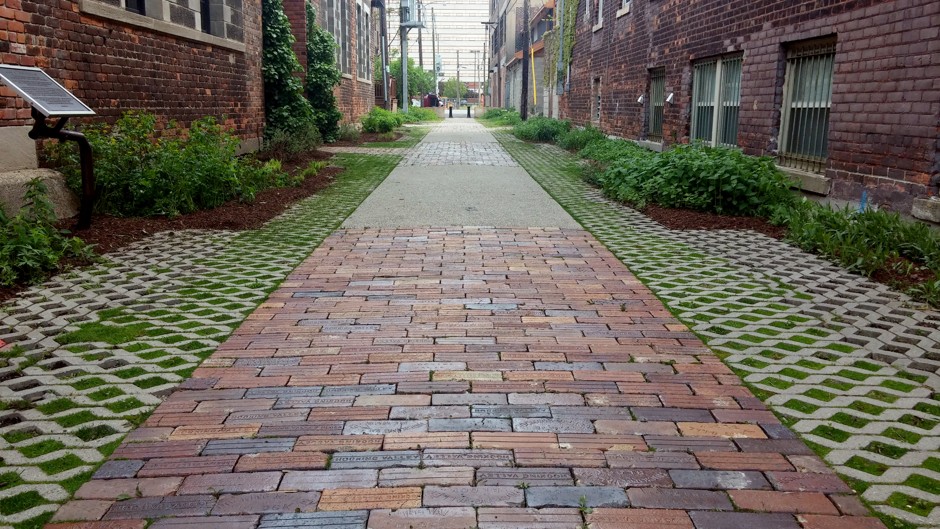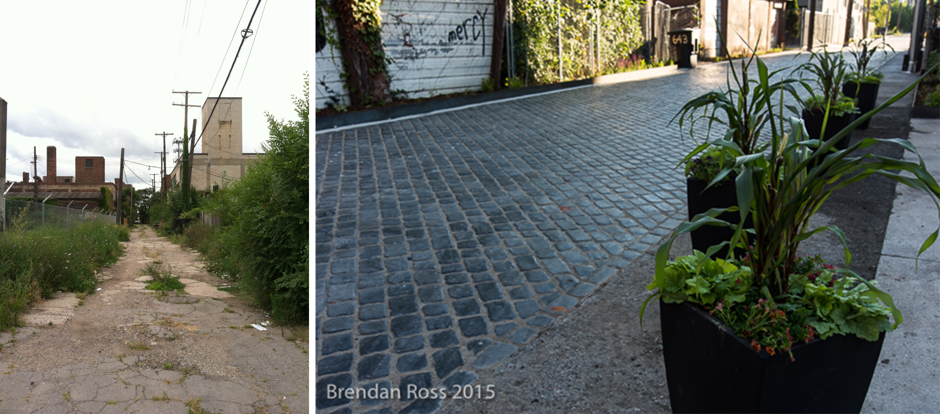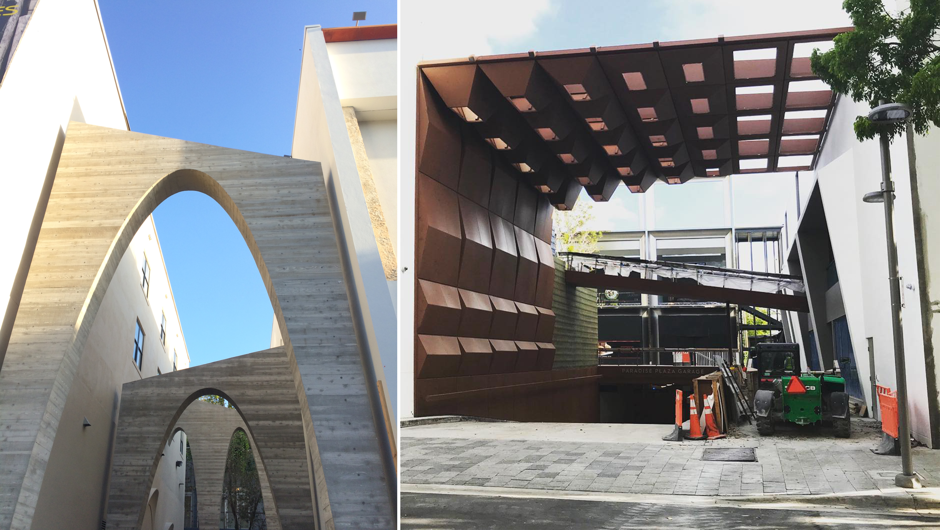Finding the Untapped Potential of Alleys

“We’re starting to realize they’re just as powerful as a park or plaza.”
In the early aughts, a former skateboard kid named Daniel Toole was chafing at his slick corporate marketing job in Seattle. To feel more like his rulebreaking teenage self, he cut through back alleys on his way to work. He liked their grittiness and started taking pictures. Sometimes people threatened to kick Toole’s ass, which he handled just fine until three of those people were FBI agents. Turned out he’d photographed the security cameras on their building. They wiped the camera’s memory and warned him never to come back.
It’s a scene that’s just shady enough for its setting, but it made Toole wonder: Do alleys have to be such unwelcoming spaces? Today, Toole, 31, is the architect behind Jade and Steel Alleys, an expansive new project in the ultra-luxe Miami Design District. A recent graduate of Harvard’s Graduate School of Design, he’s imagined spaces in the Design District alongside projects by world-renowned architects including Buckminster Fuller, Sou Fujimoto, and Patricia Urquiola.
That’s because Toole has become an expert in alleys. He has landed fellowships to study alleys around the world and gained a following for his blog about them. For centuries, he says, back alleys had evolved and served densely walked, commercial functions in world cities as disparate as Kyoto, Istanbul, and Melbourne. It hasn’t always happened that way in the U.S., but that may be starting to change.
“The American alley is on the rise for sure,” he says. “Because I think the alley in an Asian or European city goes through cycles—they’re more built into the fabric. They were always a place for people to be, whereas in America they were for horses or cars or garbage, and now we’re starting to realize they’re just as powerful as a park or plaza, potentially.”
Toole timed it well. Four decades ago, an obscure Louisville academic named Grady Clay wrote a small book called Alleys: A Hidden Resource, arguing that back alleys represented apple-pie-level Americana; most older cities in Europe and elsewhere hadn't been designed with utility routes behind the houses. As American cities and suburbs sprawled out, though, alleys were undervalued, and Clay’s book got little notice.
In 2011, Toole published his own book, Tight Urbanism, to more attention. He argued that alleys could add more commercial and communal value to cities: Melbourne, Australia, has made its “laneways” into some of its liveliest bar-and-restaurant scenes. Montreal has cultivated 250 “ruelles vertes,” or green alleyways, as neighborhood gathering and play space. Other cities from Kyoto to Istanbul to Stockholm have attracted pedestrians to their alleys for centuries.
Now American cities like Detroit, Chicago, Nashville, and Seattle are rethinking their alleyways, too. How much can an alley add to U.S. city? Showplace projects like in Miami’s Design District and Washington, D.C.’s waterfront development, the Wharf, are working to prove their potential.
An Edgy History
The wide trash-pickup-type alleys were actually unique to the United States, Grady Clay argued 40 years ago. His 1978 book traced the history of alleys in this country more deeply than anyone else seemed to have cared to. “To skulk through an American alley is to step backward in time, downward on the social ladder, and quickly to confront the world of trash collectors, garbage-pickers, weekend car mechanics and children,” he wrote.
“A few glaring exceptions—unpaved tracklets through old bucolic suburbs, or posh little stashes of elegant townhouses along alleys in Georgetown, D.C.—silhouette themselves against a dark majority,” he added. “Out of sight, the American residential alley has been the academic, geographic and social outcast of the built environment for at least a half-century.”
In the centuries before World War I, Clay wrote, alleys had been vital to American cities, hosting everything from stables to housing. After the Civil War, for instance, 300,000 newly freed slaves lived in improvised housing along Washington, D.C., alleys, especially in the Southwest quadrant. By the 1920s and ’30s, cheap tract development needed only easements out back, and boatlike “affluential token” cars were meant to be parked out front. By 1961 the Community Planners' Handbook advised: “Alleys are no longer desirable nor considered necessary. Their disappearance is one of the advances which has been made in land planning during the motor age.”
Clay was among the few to argue that American alleys could and should be reimagined. They could be used as space for homes and businesses, he said, predicting that commuting costs would increase and older city blocks would shoot up in value. Almost a half-century later, commuting costs have indeed grown, many older city blocks have rebounded to command the highest prices, and walkable neighborhoods have become some of the nation’s most desirable.
The U.S. seems to have come around to Clay’s arguments, and those of undersung counterparts like social reformer Jacob Riis and New Yorker architecture critic Lewis Mumford, who also found alleys alluring. “More often than not,” Mumford wrote, “I would prefer to walk in the rear alley, precisely for all those little hints of life, activity, transition which the placid visual arts of suburbia did their best to suppress or politely disguise.”
A Fresh New Look
Today, boosters in many cities are seeking to make alleys more hospitable and intriguing, and eyeing them as passageways that add commercial, community, environmental, and most recently, retail and design value.
Much of the American-alley redevelopment that was done in the past five or 10 years in places like Detroit and Seattle has had a neighborhood-DIY feel, with a few citizens banding together to raise improvement funds as they went (or, as in the case of Chicago’s citywide-repaving case, a more utilitarian sustainability purpose). Detroit’s efforts just outside downtown, for instance, started with a single demonstration project, the Detroit Green Alley, by a set of environmentalists teaming up with a brewery. Now, alleys in the city are being resurfaced and greened up one by one with funding from the community-development group Midtown Detroit Inc.
And designers are also creating some glitzy, large-scale projects. Toole’s brand-new pair of showplace alleys in Miami’s Design District is a key example. A once-decaying neighborhood between Miami Beach and Midtown, the Design District was reimagined by developer Craig Robins, with backing from luxury brand LVMH, into an ultraglam art gallery of an outdoor mall, with showstopping facades on high-end stores like Bvlgari, Hermès, and Piaget.
Its recently opened Jade Alley often pops up on Instagram, hosting a crowd that enjoys the spiked ice cream from a 21-and-up ice cream bar along it, bringing their quarter-pints outside to enjoy under the alley’s parabolic arches and flowering trees.
On an evening earlier this spring, pairs of stylish guests wandered down Jade Alley’s scalloped stone pavers to a cocktail party, while other visitors chatted at bistro tables outside. One or two browsed Eres, a French lingerie boutique that Grady Clay would likely have approved of; he wrote about how Parisian alleys were “laden with mystery and almost erotic meaning,” and how Boston alleys were where everybody first got laid.
Toole, who was influenced first by Clay’s thinking, then by his own travels, modeled the Jade Alley in part on the cathedrals and alleys of Italian hillside towns like Siena. The grand parabolic arches he created are a deliberately rough, grainy concrete. “After doing all the research and travel over the last 10 years, I realized that if you overdesign or use the wrong materials, you pretty much destroy the fact that it was an alley,” Toole says. “With the recycled brick, rough concrete, textured granite cobblestone, and the applied stucco, it still feels rough even though it’s partially brand-new.”
The Wharf, a splashy waterfront development in Washington, D.C., that opened in October, has tried adding alleys back to the very quadrant of the city where they were once ubiquitous, before being largely redeveloped and superblocked out in the mid-20th century. Project developer Monty Hoffman was hyperconscious of its social history as he tried to create a brand-new neighborhood that would actually feel real. “This location was an urban renewal project for the federal government, the first and worst in the entire country,” he says. “There were 600 acres that were almost clear-cut to make way for a highway and apartments and federal buildings. We’re trying to revive it.”
Hoffman and lead designer Stan Eckstut of Perkins Eastman toured what they called the “amazing” alleys of world cities like Seville, Helsinki, Sorento, and Barcelona. Then they tried the opposite of superblocking, creating Wharf mini-blocks that are 260 feet long, rather than the standard 600 to 800 feet, with passageways between. “We studied all the spatial relationships and what worked and didn’t work,” Hoffman says. “One thing was making the spaces smaller so that it appears a little bit crowded, which is better than having a large expanse of public space that feels sterile and cold. It’s more porous, with lots of connectors. That provides tremendous light and air to the buildings.”



Comments
Post a Comment